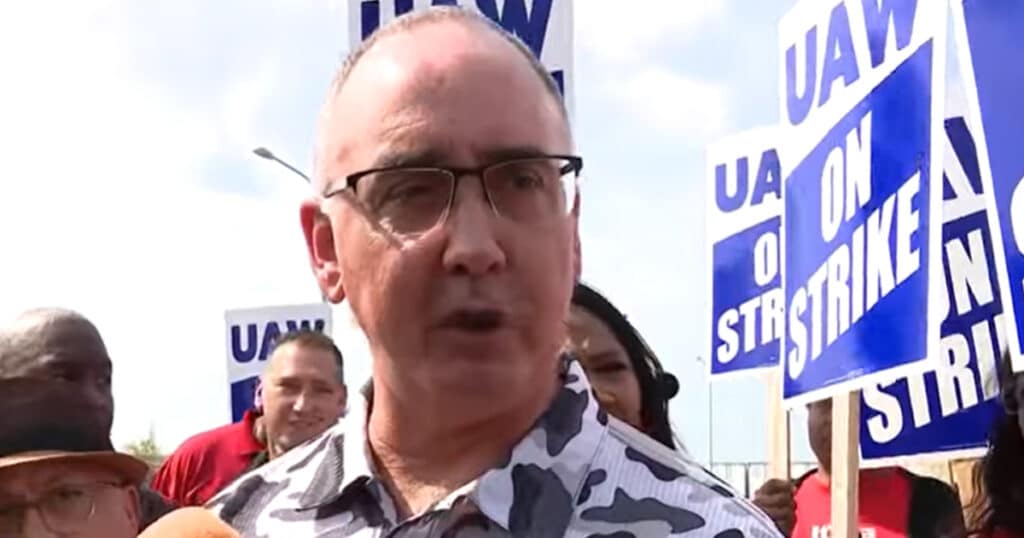
UAW’s Real Enemy Is Forced EV Conversion
Speaking at a convention in April, United Auto Workers President Shawn Fain identified what he considered the union’s “one and only true enemy – multibillion-dollar corporations and employers that refuse to give our members their fair share.” He may be attacking the wrong enemy.
The UAW is now engaged in a strike of historic proportions against America’s big three auto manufacturers: GM, Ford, and Stellantis (owner of Chrysler). But it’s the Democratic Party’s climate activists who pose the most significant threat to American auto workers today – the forced transformation of the U.S. auto industry from gas to electric-powered vehicles (EVs).
As for the strike, the UAW’s demands include a stunning 40% pay raise over the next four years. According to CEO Jim Farley, that increase would put Ford “out of business.” Yet, in a response that hardly seems miserly, Ford has offered a 20% increase over the life of the contract and an immediate 10% increase.
For a starting point in negotiations, it’s strong evidence of good faith, if not generous. GM and Stellantis will likely make offers in that range. But the final number won’t mean much to the union workers whose jobs disappear.
Turns out that it takes 40% fewer employees to manufacture EVs than it does to manufacture gas-powered vehicles. According to a recent analysis by James Sherk and Jacob Sagert at the America First Policy Institute, the Biden administration’s proposed EV rules will eliminate at least 117,000 existing auto manufacturing jobs.
In addition, the majority of EV jobs won’t be union jobs. They will either go to non-union companies (such as Tesla) or right-to-work states in the South. In those states, workers can’t be compelled to join a union, which explains why so many foreign manufacturers have opened their U.S. plants there.
Part of the problem is that the Democrats’ climate bill (ironically named the Inflation Reduction Act) promotes the use of “domestic” labor rather than “union labor.” That was the result of lobbying by foreign auto manufacturers, many of which have or intend to build plants in right-to-work states. It’s also evidence that the climate-activist wing of the Democratic Party is more concerned with promoting EVs than with preserving jobs for their traditional union allies.
In fact, to accomplish its EV goals, the Biden administration is attempting to force them on consumers who just don’t want them. According to the Deloitte 2023 Global Automotive Study, 62% of Americans prefer their next car purchase to be a gas-powered vehicle, 20% prefer a hybrid, and a mere 8% prefer a pure EV.
So, perhaps it’s not surprising that Ford, the second-largest seller of EVs with 7.5% of the market, can’t sell all the EVs it’s producing despite losing nearly $60,000 on every sale. This year alone, Ford estimates it will lose $4.5 billion in its EV business. That’s money that could be available to meet the UAW’s demands if the Biden administration weren’t pushing EVs on American consumers – and manufacturers.
The problems the UAW is facing should not come as a surprise. Given the lack of consumer demand, the transition to EVs will only occur if the government suppresses the free market and forces a conversion. There are always unanticipated consequences when government elites impose their will rather than allowing consumer demand and the free market to guide the economy. It’s one of the primary reasons socialism always fails.
The unintended consequences of the administration’s green agenda will be numerous and consequential. The rare-earth minerals necessary for battery production come from foreign countries, where they are extracted using forced labor and child labor. Mining those ores, and then disposing of the batteries at the end of their useful lives, will cause long-term environmental damage. Moving to EVs at scale will increase America’s reliance on China, where the batteries, their components, and the great majority of EVs are manufactured. Finally, America’s electricity grid, which is already stressed, is likely to be overwhelmed once a large segment of the population is using it to power their cars.
The current strike is one of these unintended consequences, as the union sees EV jobs moving to non-union companies, right-to-work states, and China. Discussing the EV transition in an op-ed earlier this month, Fain stated that “at stake in these contract negotiations is the very future of the auto industry itself – and workers’ place in it.” Given the Biden administration’s push for EVs, is it any wonder that the UAW has yet to endorse President Biden for 2024?
Certainly, no one could blame workers for believing climate activists in the Democratic Party are selling out their union supporters. It’s an unintended consequence that could be a game-changer in next year’s election. Even if the big three auto manufacturers meet the union’s demands on wages, the EV problem will not go away.
Nevertheless, President Biden appeared on the UAW picket line in Michigan on Tuesday, attempting to walk a fine line between supporting striking workers and giving the presidential stamp of approval to the union’s specific demands. Bullhorn in hand, he told the crowd, “You guys, UAW, you guys saved the automobile industry. … You should be doing incredibly well too.” He didn’t take questions.
Donald Trump sees an opening. Already popular with union workers, though perhaps not their leaders, Trump recently pointed out the obvious – EVs are “a disaster for both the United Auto Workers and the American Consumer” that would “wipe out” the UAW. He’s skipping next week’s Republican presidential debate and visiting Detroit to speak with striking auto workers. The reception he gets may be telling.
This article was originally published by RealClearPolitics and made available via RealClearWire.



